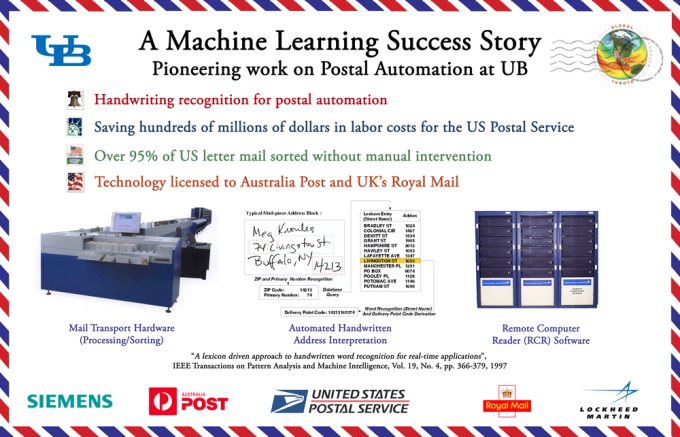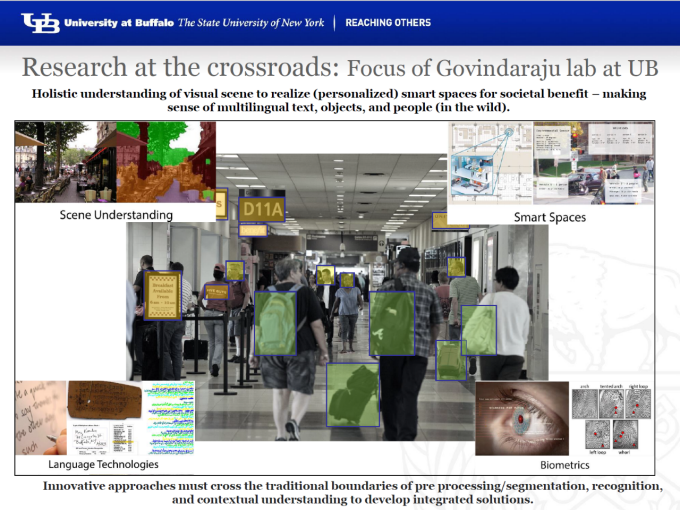Pioneers in AI Systems

Professor Govindaraju's work in handwriting recognition was at the core of the first handwritten address interpretation system used by the United States Postal Service.
On this page:
Impact on Computerized Handwriting Recognition
Govindaraju's research focuses on machine learning and pattern recognition and his seminal work in handwriting recognition was at the core of the first handwritten address interpretation system used by the U.S. Postal Service.
The learning-based system that Govindaraju developed as project technical lead along with his colleagues at the University at Buffalo helps save the USPS hundreds of millions of dollars by automatically processing, and barcoding for precise delivery, over 25 billion letters a year. This work was highlighted in the Computing Community Consortium's symposium on Computing Research that Changed the World in 2009 as one of the most successful applications of Machine Learning for developing a real-time engineered AI system.
Building on this significant achievement, Govindaraju has made critical contributions to more general handwriting recognition including multilingual OCR of Indic, Arabic and other scripts , impacted the humanities with his work on historical document processing, influenced web security by his work on handwritten CAPTCHAs and is now spearheading innovations in AI driven augmentations for learning with his award winning work on content-based indexing and summarization of lecture videos and presentations.
Over the past two decades, he has also made significant contributions to the field of Biometrics, including advances in fingerprint and face recognition, signature identification, multi-biometric fusion, and soft biometrics.
Globally recognized for his groundbreaking research, Govindaraju has received numerous honors, including the IAPR/ICDAR Outstanding Achievements Award, IEEE Technical Achievement Award and fellowships of major professional societies including the National Academy of Inventors, IEEE, ACM, AAAS, SPIE, and IAPR. He holds four (4) patents and authored/co-authored over 450 scientific papers. He has served on the editorial boards of premier journals such as the IEEE Transactions on Pattern Analysis and Machine Intelligence and as editor-in-chief of the IEEE Biometrics Council Compendium.
Recognition from the Computing Community Consortium
The Computing Community Consortium refers to the seminal work:
- March 25, 2009: Computing Research that Changed the World: Reflections and Perspectives, “… Automated handwriting analysis seems easy but there are many ways to write each number or letter. Using a learning-based system developed at UB by Venu Govindaraju and colleagues, 25 billion letters a year are processed automatically by the US postal service bar-coded for precise delivery saving hundreds of millions of dollars...” (Presentation by Daphne Koller, member of NAE, Minute 7:00 – 8:00)
- June 7, 2016: AI in Support of People and Society, “An early success story in the 90s widely considered the winter of AI…It is one of the first practical success stories of AI and as a shining example of AI for the Social Good.” (Presentation by Eric Horvitz, Fellow of NAE, Minute 4:15 – 5:00)
Two Decades of Innovations in Handwriting Recognition
The National Cancer Institute invited Professor Govindaraju to present:
- October 25, 2017: CBIIT Speaker Series: Dr. Venu Govindarau, Handwriting Recognition: A Perspective on Two Decades of Innovations
Mail Processing Systems
United States Postal Service
- USPS Engineering Vice President William J. Dowling singled out Lockheed Martin and its suppliers, the State University of New York at Buffalo, and Parascript, LLP, for their work in improving RCR performance. Edward Kuebert, manager of image and telecommunications technology at USPS also credited improvements in reader technology to the State University of New York at Buffalo, Lockheed Martin Federal Systems and the Parascript Group of Boulder, Colo.
- 1997 Annual Report of the United States Postal Service, Page 43, "For years, we have worked with the State University of New York (SUNY) at Buffalo to improve the technology we use to recognize handwritten addresses. While the technology we use to electronically read typed or printed addresses has been very successful, we have had only limited success in recognizing handwritten addresses because there is such variation in styles of handwriting. When we first deployed them, Remote Computer Readers could fully resolve about one-third of the printed images they received but less than two percent of the handwritten ones. For handwritten mail, the Readers could partially resolve some of the five-digit ZIP Code mail. Then we conducted a pilot test of an early version of handwritten address interpretation technology. This early version could fully barcode about one of every eight hand-addressed images it received. This year, our research has started to pay off as we began deploying the latest software and equipment designed to electronically read, decipher, and automatically barcode many of the billions of pieces of handwritten addressed mail we process each year.”
- 1999 Annual Report of the United States Postal Service, Section, Gateway to the Household: Automating: "During the 1998 holiday mailing season, 50% of all handwritten card and letter addresses were 'read' not by human eyes but by high speed sorting machines, a process that resulted in labor savings of $31 million.”
- Government Executive, February 1, 1999: Postal Service tests handwriting recognition system, "USPS issued a contract to researchers at the State University of New York at Buffalo to develop the handwriting recognition technology. It was first launched in 1997 right before the Christmas holiday season...One year later, an estimated 400 million pieces of mail were automatically routed during the Christmas season alone using the handwriting recognition technology…The new technology has saved the Postal Service at least $90 million in its first year in the field." Postal Service Tests Handwriting Recognition System
- Lockheed Martin provides USPS increased letter mail address recognition capability, June 10, 1999: "Lockheed Martin Postal Systems will be providing increased letter mail address recognition capability for 255 U.S. Postal Service (USPS) automated mail processing Remote Computer Reader (RCR) systems. The contract, called RCR2000, has a potential value of $153.8 million. Lockheed Martin will increase the RCR system's recognition capability to approximately 63 percent for handwritten letter mail by the end of 1999 and to 70 to 75 percent by the end of 2000. RCR handwritten recognition rates have improved dramatically, from two percent in 1997 to the current 53 percent, resulting in significant operational efficiencies for the USPS. The RCR2000 program also will increase the USPS' recognition capability for machine printed addresses at least five to seven percent by the end of 1999. This contract includes incentives for handwritten "read" rates above 75 percent and decreased error rates. In praising the efforts of private industry and the academic community for helping drive breakthroughs in mail processing technology, USPS Engineering Vice President William J. Dowling said, "This has been a true partnership to take advantage of emerging computer and character recognition capabilities." Dowling singled out Lockheed Martin and its suppliers, the State University of New York at Buffalo Center of Excellence in Document Analysis and Research, and the Parascript, LLP, for their work in improving RCR performance. The RCR2000 program will enhance the USPS' recognition capability through a series of software algorithm and hardware upgrades. Lockheed Martin will initiate deployment of the RCR2000 program in August 1999. The USPS, the most highly automated postal system in the world, with more than 12,000 pieces of mail processing equipment and nearly 40,000 post offices, has been able to use technology initiatives such as the RCR2000 program to constantly improve service, while maintaining the lowest postage rates in the industrialized world. Lockheed Martin Postal Systems is a leader in the design, production and systems integration of a broad product portfolio of recognition, sortation, material handling and information management systems equipment and technology for postal and commercial customers. It is part of the Lockheed Martin Electronics Platform Integration organization, which provides advanced-technology products, services and systems integration solutions. The organization is an operating unit of the Lockheed Martin Electronics Sector, which designs, develops and produces advanced components and systems for military, civil government and commercial customers around the world."
- The Atlantic, December 4, 2011: Tech Has Saved the Postal Service for 200 Years..., “The Postal Service is a giant delivery machine. It bridges the physical and digital using any combination of humans and robots that works. The USPS delivers half the world's mail -- that's 563 million pieces each and every day of 2010. To do so, it employs 574,000 people and 10,000 pieces of mail-sorting equipment. If the Postal Service were a company, it would have been number 29 on the 2010 Fortune 500 list…... Think of all the problems that the USPS has had to solve to become and remain this massive country's only completely inclusive point-to-point network…Just one example: The Postal Service's OCR machines correctly translate the chicken scratch that passed for an address on 93 percent of hand-lettered envelopes.”
Australia Post and Royal Mail
- Licensed address reading technology to the national Postal Services in the United States, Australia, and the United Kingdom. “He also was responsible for technology transfer to Lockheed Martin and Siemens Corporation for the system's deployment by the U.S. Postal Service, Australia Post and UK Royal Mail.”
Handwriting Processing for the Humanities
- The New York Times, May 15, 2003: A New Tool for Translating Ancient, Flowing Script, “With optical character recognition technology, Sanskrit documents could be transformed into digital text that could be viewed on computer monitors using existing Devanagari screen fonts.”
Handwriting for Computer Security
- MIT Tech Review, January 9, 2009: A Joined-Up Bot-Fighting Strategy, “In the battle to beat the spambots, a new weapon has been developed that exploits the difficulty that computers have with recognizing joined-up handwriting. The hope is that switching from text-based verification systems to systems that use computer-generated handwriting will make many Web services more secure.”
Augmented Learning Using AI
- UB Communications, November 14, 2019: Facilitating augmented learning using AI, "Increasingly, massive open online courses (MOOCs) and other learning portals are providing a variety of online educational resources to large audiences, both of the award winning papers by Govindaraju's students address different approaches for using machine learning to make lecture videos more accessible for search and information retrieval by students.”
Awards from Professional Societies
International Association for Pattern Recognition
Received the highest award from the major professional society in the field:
- August 26, 2015 (Nancy, France): International Association of Pattern Recognition (IAPR) / International Conference on Document Analysis and Recognition (ICDAR) Outstanding Achievements Award, “For pioneering contributions to pattern recognition and its application to the fields of handwriting recognition, multilingual document analysis, and biometrics; and for the development of real-time engineered systems.”
- ICDAR 2015 Keynote Address: "Navigating Scientific Literature: A Holistic Perspective", Venu Govindaraju
Institute of Electrical and Electronics Engineers
The IEEE Computer Society presented its 2010 Technical Achievement Award to Venu Govindaraju for his pioneering contributions to biometrics systems. The Technical Achievement Award honors outstanding and innovative contributions to computer and information science and engineering, usually within the past 10 years. Dr. Govindaraju accepted his award at the Computer Society's 9 June 2010 awards ceremony in Denver, Colorado.
Other Honors
- Fellow: ACM, AAAS, IAPR, SPIE
- Fellow of the National Academy of Inventors
- Indian Institute of Technology (IIT) Distinguished Alumnus Award
- MIT Global Indus Technovator
- SUNY Chancellor’s Award
- ICDAR Outstanding Young Investigator Award
Industry Awards
- HP Open Innovation
- IBM Faculty Research
- Google Faculty Research
- eBay Faculty Research
- Fujitsu Faculty Research
